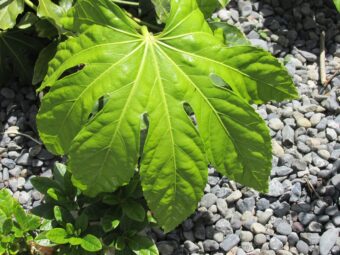In this article, we will discuss how to grow this beautiful architectural plant Fatsia in containers. The one species that tend to be grown on containers is Fatsia japonica and this is the one that will be described in this article.

Fatsia japonica is an evergreen shrub that can grow up to 1.5m high in containers that have wonderful elegant leaves. It has many common names from umbrella plant, Japanese Aralia to False Castor Oil plant due to the leaves having a resemblance to the castor oil plant.
Fatsia originates from the Orient and therefore will do well if the growing conditions are replicated in the home garden. This is one plant that does not like full sun, the more shade you offer the better the plant will do.
THEY ARE GROWN FOR THE LEAVES
The leaves are the main reason why the plant is grown but in mature plants, it will produce interesting, spherical-shaped, white flowers that appear in autumn. After this, they are followed by black berry-like fruits. For a shrub, it can be seen as a medium-sized shrub that likes low lighting levels. It also not fussy as to what type of compost or soil that it is grown in but it does not like going from one extreme to another.
Fatsias are hardy plants and can survive temperatures as low as -10 degrees Celsius and this is why it is best to situate it in a place where the container is sheltered from the cold and strong winds. Variegated forms are less hardy and should be used as a houseplant in the UK and not planted outside unless it is protected or planted in a mild area. One of the beauties of growing Fatsia is that it is a low maintenance plant that needs little in the way of attention.
HOW TO GROW FATSIA JAPONICA IN CONTAINERS
As Fatsia are medium-sized shrubs, it is best to use as big a container as possible, ideally a half-sized oak barrel. As long as it is high as well as wide it will do well.

One thing that must be mentioned is that the Fatsia you buy is suitable for growing outside as most are grown for houseplant use. If you buy a Fatsia from the houseplant section of the Garden centre, make sure that you harden it off before planting it in the garden. Choose a position that is sheltered from the cold, strong winds in partial or full shade.
Dig a hole twice the size of the root ball and sprinkle some granular fertilizer like growmore into the hole. Place the plant in the centre of the hole, backfilling it with compost to the same depth as it was in the original container. Fill any gaps and firm the root ball gently so that the plant will not move. Water in and allow the compost to settle.
The best-growing media to use is a mix of 70% by volume of multipurpose compost mixed with 30% by volume horticultural grit.
The plant should be fed monthly between March and September by using something like growmore. Alternatively, you can use a slow-release fertilizer to give it enough nutrients to last the growing season. Make sure it is kept moist throughout the growing season but the compost must never be overwatered. Water when at the first knuckle of your middle finger feels dry to the touch when you stick it in the compost.
USE A SLOW GROWING VARIETY
It is recommended that in containers you use a slow-growing variety. A variety of Fatsia japonica ‘Spider’s Web’ is suitable for this purpose, as it is frost hardy and only grows up to 2.5m in height. Fatsia in containers will need to be pruned to keep in size and shape.

As it matures some stems will become straggly. These will need to be cut off where new shoots will appear from the base to take their place. Any pruning to shape, size or to get rid of old stems must occur in late spring. Oversized plants can be pruned to half of their height and width at the same time. Younger plants less than 2 years will need to be watered regularly but most certainly when the compost is dry, especially in a hot summer.
The shrub is surprisingly disease and pest free. In spring, young leaves may get damaged by frosts but they will soon put out new growth.
VARIETIES TO GROW
The one species to grow is Fatsia japonica as stated earlier in this article. It has wonderful large, green, glossy, palmately lobed leaves that make an architectural beauty to look at.
There is a new Fatsia variety called Fatsia japonica ‘Spider’s Web’ that had large, lobed, white-green variegated leaves It is often green in the centre and white at the edges, It is a hardy variety and much shorter than other varieties, only reaching 2.5m in height. It is also easy to cut back when you want to and therefore a suitable species to grow in containers. Another variety to look for is ‘Variegata’.
CONCLUSIONS
In this article, we have discussed how to grow Fatsia Japonica in containers to bring this architectural plant to your garden. They are generally easy to grow, apart from spring fertilizing and regular watering in dry weather. You do also have a choice from the normal, plain varieties to the variegated, more compact variety of ‘Spider Web’.
If you are prepared to do this, then you can grow this shrub in a container in the patio area.
If you have any questions or comments that you wish to make on growing Fatsias in containers, then please do so in the comment box below.
Happy Fatsia growing.
